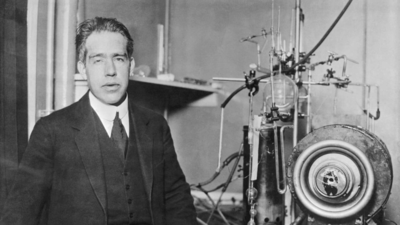- News
- Education News
- Instant Scholar: Niels Bohr's Nobel Lecture; revolutionising the understanding of atomic structure
Trending
Instant Scholar: Niels Bohr's Nobel Lecture; revolutionising the understanding of atomic structure

Introduction to Bohr's Model of the Atom
Bohr’s atom model incorporated quantum theory, which was still in its infancy. His model proposed that electrons move in discrete orbits around the nucleus and that these orbits had specific energies. This was in stark contrast to the classical view of electrons moving in continuous paths. Bohr’s model helped explain why atoms emitted light in distinct spectra rather than a continuous range.
The Bohr Model and Its Impact
- Electrons Orbit in Stable Orbits: Electrons move in fixed orbits or "shells" around the nucleus without radiating energy, contrary to classical electromagnetic theory, which predicted that electrons would lose energy and spiral into the nucleus.
- Quantized Energy Levels: The energy of the electron is quantized, meaning that electrons can only occupy specific orbits with defined energies. This explained the spectral lines observed in atomic spectra, as electrons could only jump between these orbits by absorbing or emitting precise amounts of energy.
- Radiation Emission and Absorption: Bohr explained that when an electron moves between orbits, it either absorbs or emits a quantum of light, known as a photon. The frequency of this photon corresponds to the difference in energy between the two orbits, explaining the discrete nature of atomic spectra.
- Angular Momentum Quantization: Bohr introduced the concept that the angular momentum of an electron in orbit is quantized and can only take integer multiples of h/2πh/2\pih/2π, where hhh is Planck’s constant. This quantization explained the stability of electron orbits and their energy levels.
Significance of Bohr’s Ideas
Moreover, the model was able to explain the hydrogen atom’s spectral lines, a problem that had baffled scientists for years. By applying quantum theory, Bohr demonstrated that the observed spectra of hydrogen could be explained by the transitions of electrons between quantized energy levels.
Quantum Theory and the Bohr Model’s Limitations
Bohr acknowledged that his atomic model was an approximation and that further work in quantum theory would be needed to fully understand the behavior of atoms, particularly multi-electron systems. This led to the development of the more advanced quantum mechanical models in the 1920s and 1930s, such as those developed by Werner Heisenberg, Erwin Schrödinger, and Paul Dirac, which incorporated wave-particle duality and uncertainty principles.

Role of Bohr model in advancing quantum mechanics
Moreover, the Bohr model was crucial in shaping the philosophical implications of quantum mechanics, especially in the interpretation of quantum states and measurements. Bohr’s philosophical insights into the nature of reality and the role of observation in determining physical phenomena were later formalized in the Copenhagen Interpretation of quantum mechanics, which he co-developed with Werner Heisenberg.
Bohr’s influence on the scientific community
Bohr was also instrumental in establishing the Institute for Theoretical Physics in Copenhagen, which became a hub for the development of quantum mechanics and attracted many future Nobel laureates, including Heisenberg, Schrödinger, and Dirac. The institute became the center of a vibrant scientific community that worked on the most pressing problems in physics during the first half of the 20th century.
Niels Bohr’s Nobel Lecture in 1922 was a key moment in the history of physics. His model of the atom, built upon quantum theory, fundamentally altered the way scientists viewed the atom, providing a coherent explanation for atomic stability, spectral lines, and the interaction between electrons and light. Though his model had limitations, it was a crucial step in the development of quantum mechanics and had far-reaching implications for physics, chemistry, and philosophy.
Through his work, Bohr contributed to the intellectual foundation of modern physics, and his insights paved the way for the development of quantum mechanics, which continues to shape our understanding of the physical world today. His Nobel Lecture remains a testament to his brilliance and the transformative impact of his work on the scientific community.
Here is the full document
('Instant Scholar' is a Times of India initiative to make academic research accessible to a wider audience. If you are a Ph.D. scholar and would like to publish a summary of your research in this section, please share a summary and autherisation to publish it. For submission, and any question on this initiative, write to us at instantscholar@timesgroup.com)
Stay updated with the latest education news on Times of India. Explore the CBSE date sheet for Class 10 and 12 across Arts, Science, and Commerce streams.
End of Article
FOLLOW US ON SOCIAL MEDIA
Visual Stories
Hot Picks
TOP TRENDING
Explore Every Corner
Across The Globe










